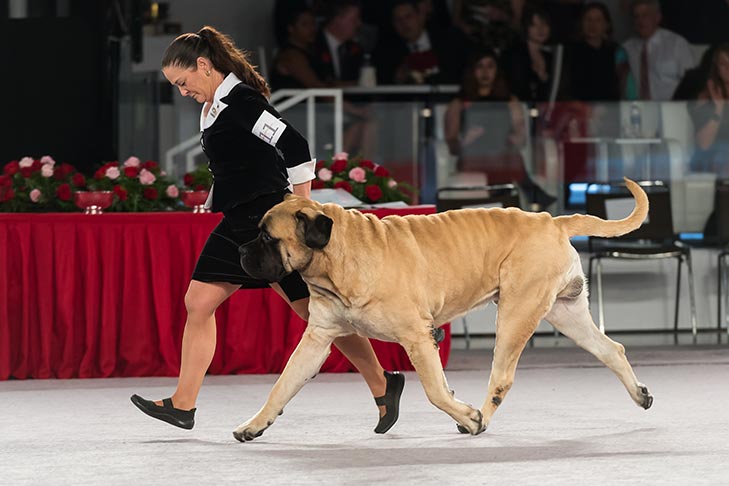
The calm, sensitive, and self-assured Mastiff is an enormous, powerful dog with a long history. These excellent guard dogs from the Working Group also make perfect foot warmers and couch-potato companions. Here are nine interesting Mastiff facts to know.
1. Mastiff-Like Dogs Appeared in Ancient Art
There is evidence that Mastiff-like dogs lived in the mountains of Asia, dating back almost 4,500 years to 2,500 B.C.E. The British Museum houses bas-reliefs from the Babylonian palace of Ashurbanipal that show dogs that look incredibly similar to modern Mastiffs hunting lions in the desert.
2. The British Are Likely Responsible for Today’s Mastiff
Folklore includes tales of Phoenician traders bringing Mastiffs with them to ancient Britain. The Romans discovered them there and took them home with them to fight in the arena. The British used the dogs to guard their estates and castles, letting them loose at night to keep intruders away.

3. War-Trained Mastiffs Accompanied Hannibal Across the Alps
During their long journey, these dogs encountered many local breeds, and when nature took its course, several new breeds were formed, including the Saint Bernard, once called the Alpine Mastiff. Mastiff blood is found in the ancestry of all the giant mountain dogs of the Balkans, Turkey, Spain, and France, leading to their massive size.
4. Mastiffs May Have Come to America With Colonists
Although records are scarce, it seems that the Plymouth colonists on the Mayflower had a Mastiff and a spaniel with them on their journey to America. However, the real importation of Mastiffs into the United States didn’t begin until the late 1800s. In America and other English-speaking countries like Canada and Britain, the name Mastiff is used to refer to the Old English Mastiff.
5. The Mastiff Gives a Dignified Impression
The breed standard doesn’t provide a maximum height, but it gives a minimum height at the top of the shoulder of 30 inches for males and 27.5 inches for females. In fact, these massive dogs can range up to 36 inches tall. There is no weight given in the standard, and they can weigh anywhere from 160-230 pounds for males and 120-170 pounds for females.

6. A Mastiff Once Held the Record for the World’s Largest Dog
Zorba the Mastiff set the record in November 1989, when he was 8 years old. He was 37 inches high at the shoulder, 8 feet, 3 inches long from the tip of his nose to the tip of his tail, and he weighed 343 pounds.
7. The Puppy Phase Lasts Longer in Mastiffs
Although teenage Mastiffs are quite large, they don’t reach their final physical and mental maturity until they are 3 years old. While they are still growing, Mastiff puppies are susceptible to joint injury, so caution is needed to be sure they don’t overdo it. They can play naturally, but exercise such as long walks, jumping over hurdles, or other stressful activities should be avoided until about 18-to-24 months of age.
8. Training and Socialization Are Essential
Mastiffs are intelligent and want to please their people, but they can also be quite stubborn. If they are scared or confused, or their sensitive feelings are hurt, even by harsh words, it can be impossible to get them to do anything. Keep your training sessions short, frequent, and fun, so your dog sees it as a game, and you will find success.

9. They Don’t Need Rigorous Exercise
Despite their size, they do fine with relatively sedentary lifestyles. They’ll be in their best physical condition with a moderate exercise regime. They are wonderful at simply being a member of the family, but they also make good watchdogs and therapy dogs. If you train them and keep them in proper physical condition, they can also succeed at carting, tracking, conformation, obedience, and search and rescue.

